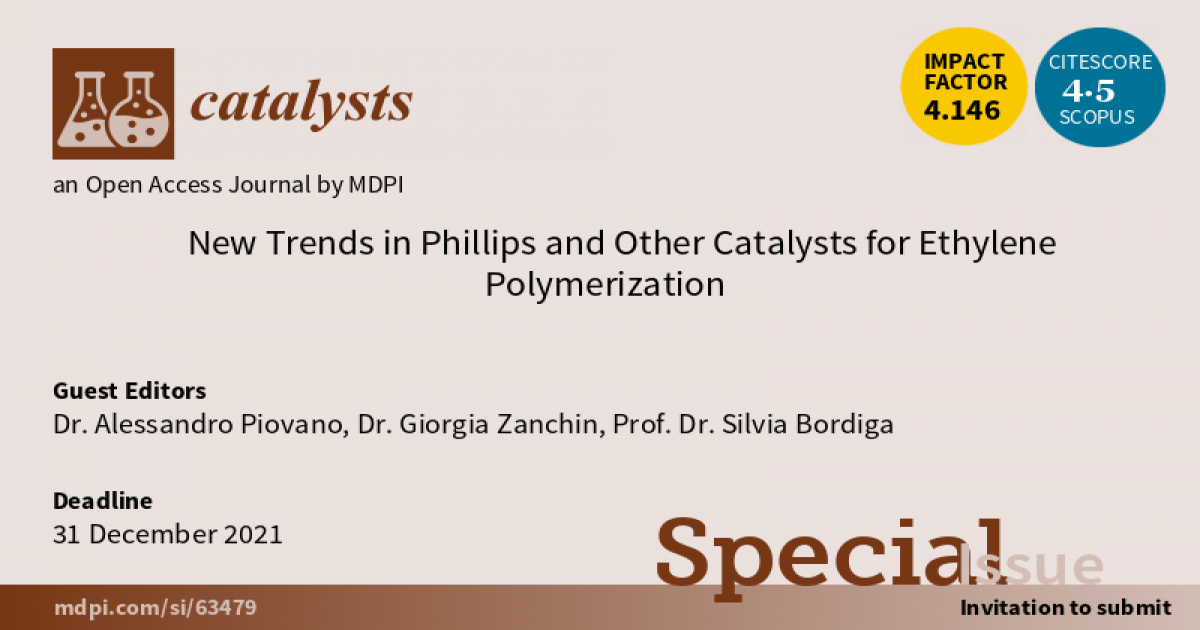New Trends in Phillips and Other Catalysts for Ethylene Polymerization
A special issue of Catalysts (ISSN 2073-4344). This special issue belongs to the section "Catalytic Materials".
Deadline for manuscript submissions: closed (31 December 2021) | Viewed by 7428

Special Issue Editors
Interests: The spectroscopic investigation of catalysts for olefin conversion, both heterogeneous (such as Ziegler–Natta and Phillips) and homogeneous (organometallic complexes)
Special Issues, Collections and Topics in MDPI journals
Interests: synthesis and characterization of organometallic complexes based on transition metals (Ti, V, Cr, Fe, Co, Ni, Cu), and their application as pre-catalysts in the polymerization of various (di)olefins
Interests: development of spectroscopic methods in order to achieve a detailed understanding of the physicochemical nature of a large variety of nanostructured high surface area materials, which find applications as heterogeneous catalysts in many processes; sustainability, strongly interconnected with energy efficiency and integration of (possibly renewable) resources in order to allow a sustainable growth of society
Special Issues, Collections and Topics in MDPI journals
Special Issue Information
Dear Colleagues,
The worldwide spread of polyolefins, and of polyethylene in particular, in the last century is intimately correlated to the development of the Cr-based Phillips catalysts, which currently account for more than 60% of the production of high-density polyethylene (HDPE), with an economic turnover of around 100 billion dollars per year. Since its discovery in 1951 by Hogan and Banks at the Phillips Petroleum laboratories, the catalyst has undergone a long and diversified process of optimization and modification, allowing the production of hundreds of different grades of PE, specific for different applications.
Despite the apparently simple general composition, chromium oxide on a high surface area supports material (mainly amorphous silica); some fundamental questions are still open, however, about the local structure of the active sites under reaction, the interconnections among the different components, and the effect of several additives used as modifying agents. Therefore, for all these years, the Phillips catalyst has attracted the attention of researchers from both companies and academia, aiming at understanding its operation mechanism and tailoring the activity toward well-defined products.
In parallel to the original investigation of heterogeneous chromium catalysts, many types of organometallic chromium complexes (actually active in ethylene oligo- and polymerization) have been disclosed and studied as homogeneous models for the Phillips catalyst, and this still remains a possible way to pursue the complexity of the catalytic system.
The goal of this Special Issue is to put together different contributions on the Phillips catalyst and on the catalysis of ethylene polymerization in general, spacing from the development of the process to the characterization of the catalysts (where appropriate, investigations on homogeneous catalytic systems will also be included).
We hope that the Special Issue will be the chance to outline new trends on this topic and to foster the network between different research groups.
We cordially invite you to submit a manuscript for consideration and possible publication. We hope this topic is of interest and look forward to hearing from you.
Dr. Alessandro Piovano
Dr. Giorgia Zanchin
Prof. Dr. Silvia Bordiga
Guest Editors
Manuscript Submission Information
Manuscripts should be submitted online at www.mdpi.com by registering and logging in to this website. Once you are registered, click here to go to the submission form. Manuscripts can be submitted until the deadline. All submissions that pass pre-check are peer-reviewed. Accepted papers will be published continuously in the journal (as soon as accepted) and will be listed together on the special issue website. Research articles, review articles as well as short communications are invited. For planned papers, a title and short abstract (about 100 words) can be sent to the Editorial Office for announcement on this website.
Submitted manuscripts should not have been published previously, nor be under consideration for publication elsewhere (except conference proceedings papers). All manuscripts are thoroughly refereed through a single-blind peer-review process. A guide for authors and other relevant information for submission of manuscripts is available on the Instructions for Authors page. Catalysts is an international peer-reviewed open access monthly journal published by MDPI.
Please visit the Instructions for Authors page before submitting a manuscript. The Article Processing Charge (APC) for publication in this open access journal is 2700 CHF (Swiss Francs). Submitted papers should be well formatted and use good English. Authors may use MDPI's English editing service prior to publication or during author revisions.
Keywords
- phillips catalyst
- chromium catalysis
- ethylene polymerization
- reaction mechanism
- characterization
- model catalyst
- insertion polymerization
- HDPE







